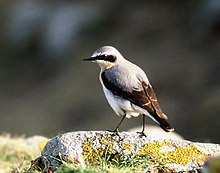The wheatears /ˈhwiːtɪər/ are passerine birds of the genus Oenanthe. They were formerly considered to be members of the thrush family, Turdidae, but are now more commonly placed in the flycatcher family, Muscicapidae. This is an Old World group, but the northern wheatear has established a foothold in eastern Canada and Greenland and in western Canada and Alaska.
| Wheatears | |
|---|---|

| |
| Male northern wheatear (Oenanthe oenanthe) | |
| Scientific classification | |
| Domain: | Eukaryota |
| Kingdom: | Animalia |
| Phylum: | Chordata |
| Class: | Aves |
| Order: | Passeriformes |
| Family: | Muscicapidae |
| Subfamily: | Saxicolinae |
| Genus: | Oenanthe Vieillot, 1816 |
| Type species | |
| Motacilla oenanthe[1] Linnaeus, 1758 | |
| Species | |
|
See text | |
| Synonyms | |
|
Cercomela | |
The genus Oenanthe was introduced by the French ornithologist Louis Pierre Vieillot in 1816 with Oenanthe leucura, the black wheatear, as the type species.[2][3] The genus formerly included fewer species but molecular phylogenetic studies of birds in the Old World flycatcher family Muscicapidae found that the genus Cercomela was polyphyletic with five species, including the type species C. melanura, phylogenetically nested within the genus Oenanthe.[4][5] This implied that Cercomela and Oenanthe were synonyms. The genus Oenanthe (Vieillot, 1816) has taxonomic priority over Cercomela (Bonaparte, 1856) making Cercomela a junior synonym.[4][6] The genus name Oenanthe was used by Aristotle for an unidentified bird. The word is derived from the Greek oenoē meaning "vine" and anthos meaning "bloom". The bird was associated with the grape harvest season.[7]
The name "wheatear" is not derived from "wheat" or any sense of "ear", but is a folk etymology of "white" and "arse", referring to the prominent white rump found in most species.[8]
Most species have characteristic black and white or red and white markings on their rumps or their long tails. Most species are strongly sexually dimorphic; only the male has the striking plumage patterns characteristic of the genus, though the females share the white or red rump patches.
The genus contains 33 species:[9]
Wheatears are terrestrial insectivorous birds of open, often dry, country. They often nest in rock crevices or disused burrows. Northern species are long-distance migrants, wintering in Africa.
{{cite book}}: CS1 maint: location missing publisher (link)